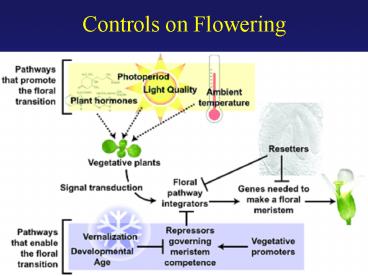Controls on Flowering - PowerPoint PPT Presentation
1 / 21
Title:
Controls on Flowering
Description:
Controls on Flowering PHY and CRY as floral regulators Photoreceptors, Rhythms, Florigen & Flowering Gene action in vernalization Controls on Flowering PHY and CRY as ... – PowerPoint PPT presentation
Number of Views:393
Avg rating:3.0/5.0
Title: Controls on Flowering
1
Controls on Flowering
2
- FLOWERING
- Light and Flowering
- Flowering types LDP, SDP, DNP
- Critical day (night) length
- A period of bright light needed prior to
darkness, additional amount of light needed to
extend day is small - Light break in night removes effect
- R/FR shows phytochrome
3
- Response to brief period of light in an extended
dark period (longer than 24 hr) oscillates
between inhibition and promotion of flowering - This shows that the state of phytochrome reacts
with rhythm rather than a simple decay in
hour-glass fashion.
4
- Rhythms
- All living organisms contain circadian rhythms
with a light (photo) phase and a dark (skoto)
phase
5
- Rhythms
- All living organisms contain circadian rhythms
with a light (photo) phase and a dark (skoto)
phase
- If light exceeds photophase it will interfere
with skotophase and reset the rhythm
6
- Measurement of phytochrome in a SDP shows that it
does changes from Pfr to Pr early in the dark
period
SDP
Phytochrome Proportion present as Pfr
Light
0
9
Hours of darkness
7
PHY and CRY as floral regulators
- phyA promotes flowering. The Arabidopsis phyA
mutant flowers later. - phyB plays an inhibitory role in floral
initiation. phyB mutant flowered earlier. - Either a mutation or an overexpression of the
CRY2 gene resulted in the reduced sensitivity to
photoperiods.
8
- Cryptochromes and phytochromes are the pigments
setting the clock in plants.
- Plants with phyA, phyB, and cry2 knocked out are
consistent with the hypothesis that these three
photopigments combine to mediate photoentrainment
9
How photoreceptors may regulate flowering time in
response to different photoperiods.
The daylength signal may be transmitted by
photoreceptors, through the circadian clock, to
affect floral initiation.
The circadian clock may regulate (gate) the
signal transduction of photoreceptors affecting
floral initiation, being permitted at the peak,
but denied at the trough of the circadian rhythm.
10
Mutations in genes that affect circadian rhythms
affect flower timing. Flower timing mutants
confer defects in circadian timing. elf3 (early
flowering 3). ELF3 is a putative transcription
factor for which both mRNA and protein abundance
oscillate. ELF3 interacts with PHYB. Late
flowering gi (gigantea). GI mRNA oscillates.
Period of leaf movement shortened in gi but
period of gene expression rhythm lengthens GI
thought to be involved in PHYB signalling. Not a
transcriptioin factor. Function unknown.
11
Summary Flowering governed by interaction
between the form of phytochrome, cryptochrome,
and the state of the endogenous rhythm, itself
originally entrained by these pigments through
dawn or dusk signals.
12
(No Transcript)
13
- The Induction Stimulus
- Plants very sensitive clock
- Number of induction cycles needed varies with
species 1 to approx. 7 - Light perceived by leaves apex responds
- Only 1 leaf needed
- Influence transmitted across a graft
- Transported in phloem
- Flowering hormone Florigen
- Consists of the product of the gene called
CONSTANS a protein or mRNA. When expressed in
phloem companion cells, plants flower. - Once flowering induced plant remains in induced
state perennials reset by time or winter dormancy
14
Photoreceptors, Rhythms, Florigen Flowering
This is for Arabidopsis, a LDP
15
- Juvenility
- Some plants will not flower in juvenile phase
- Contain phytochrome
- Hormonal state appears inappropriate for
flowering - In conifers non-polar GAs increase at maturity
- In English ivy GA causes a reversion to the
juvenile phase and this is reversed back to the
adult form by ABA
16
- Vernalization
- Low temperature promotion of flowering readiness
prior to inducing photoperiods. - Needed by plants that naturally go through a
winter prior to flowering.
17
- Vernalization
- Most such plants are LDP biennials (e.g., sugar
beet, carrot), though some may be perennials (LDP
or SDP) (e.g. chrysanthemum). - Vernalization needs 5-10o for ca 6 weeks.
- plus 4-5 days of following intermediate
temperature to stabilize the vernalization. - High temperatures prior to stabilization cause
devernalization.
18
- The longer the exposure to cold the more rapidly
floral initiation occurs.
Rye
Days from planting to flowering
50
Days of Cold
10
19
Plants requiring vernalization. (A) A biennial
cabbage (Brassica oleracea) variety growing for
five years without cold exposure vs a
summer-annual variety of B. oleracea that flowers
rapidly without vernalization.
Summer annual and vernalization-requiring types
of henbane (B) and Arabidopsis (C). Plants were
grown in LD without vernalization. In both a
single-dominant gene (FLC) is responsible for the
vernalization-requiring habit (right). The
annuals (left) have a non-functional flc allele.
20
Gene action in vernalization
Flower forming genes
21
A speculative model of an Arabidopsis circadian
clock. Light input via phytochromes and
cryptochromes is mediated through ELF3 and GI, or
through PIF3. PHYA-PIF3 and PHYB-PIF3
interactions are known to occur. PIF3 binds to
CCA1 and LHY promoters and possibly to other
targets in the clock.
(McClung 2001)

